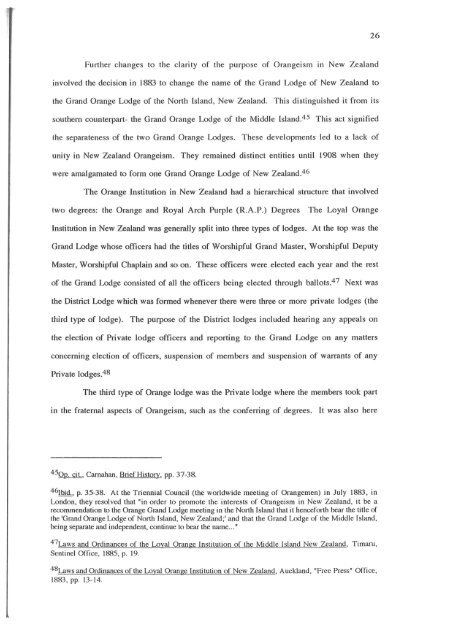TRANSPLANTED IRISH INSTITUTIONS - University of Canterbury
TRANSPLANTED IRISH INSTITUTIONS - University of Canterbury
TRANSPLANTED IRISH INSTITUTIONS - University of Canterbury
Create successful ePaper yourself
Turn your PDF publications into a flip-book with our unique Google optimized e-Paper software.
26<br />
Further changes to the clarity <strong>of</strong> the purpose <strong>of</strong> Orangeism in New Zealand<br />
involved the decision in 1883 to change the name <strong>of</strong> the Grand Lodge <strong>of</strong> New Zealand to<br />
the Grand Orange Lodge <strong>of</strong> the North Island, New Zealand. This distinguished it from its<br />
southern counterpart- the Grand Orange Lodge <strong>of</strong> the Middle Island. 45 This act signified<br />
the separateness <strong>of</strong> the two Grand Orange Lodges. These developments led to a lack <strong>of</strong><br />
unity in New Zealand Orangeism. They remained distinct entities until 1908 when they<br />
were amalgamated to form one Grand Orange Lodge <strong>of</strong> New Zealand. 46<br />
The Orange Institution in New Zealand had a hierarchical structure that involved<br />
two degrees: the Orange and Royal Arch Purple (R.A.P.) Degrees<br />
The Loyal Orange<br />
Institution in New Zealand was generally split into three types <strong>of</strong> lodges. At the top was the<br />
Grand Lodge whose <strong>of</strong>ficers had the titles <strong>of</strong> Worshipful Grand Master, Worshipful Deputy<br />
Master, Worshipful Chaplain and so on. These <strong>of</strong>ficers were elected each year and the rest<br />
<strong>of</strong> the Grand Lodge consisted <strong>of</strong> all the <strong>of</strong>ficers being elected through ballots. 47 Next was<br />
the District Lodge which was formed whenever there were three or more private lodges (the<br />
third type <strong>of</strong> lodge). The purpose <strong>of</strong> the District lodges included hearing any appeals on<br />
the election <strong>of</strong> Private lodge <strong>of</strong>ficers and reporting to the Grand Lodge on any matters<br />
concerning election <strong>of</strong> <strong>of</strong>ficers, suspension <strong>of</strong> members and suspension <strong>of</strong> warrants <strong>of</strong> any<br />
Private lodges. 48<br />
The third type <strong>of</strong> Orange lodge was the Private lodge where the members took part<br />
in the fraternal aspects <strong>of</strong> Orangeism, such as the conferring <strong>of</strong> degrees. It was also here<br />
45Op. cit., Carnahan, Brief History, pp. 37-38.<br />
46Ibid" p. 35-38. At the Triennial Council (the worldwide meeting <strong>of</strong> Orangemen) in July 1883, in<br />
London, they resolved that "in order to promote the interests <strong>of</strong> Orangeism in New Zealand, it be a<br />
recommendation to the Orange Grand Lodge meeting in the North Island that it henceforth bear the title <strong>of</strong><br />
the 'Grand Orange Lodge <strong>of</strong> North Island, New Zealand;' and that the Grand Lodge <strong>of</strong> the Middle Island,<br />
being separate and independent, continue to bear the name ... "<br />
47Laws and Ordinances <strong>of</strong> the Loyal Orange Institution <strong>of</strong> the Middle Island New Zealand, Timaru,<br />
Sentinel Office, 1885, p. 19.<br />
48Laws and Ordinances <strong>of</strong> the Loyal Orange Institution <strong>of</strong> New Zealand, Auckland, "Free Press" Office,<br />
1883, pp. 13-14.
















